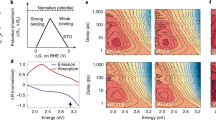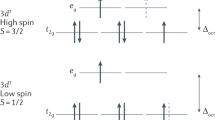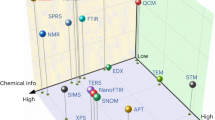Abstract
HETEROGENEOUSLY catalysed reactions usually proceed at outer or inner surfaces of materials that have large and often non-uniform surface area. Many intermediates of such chemical transformations are short-lived and escape direct detection; such transient species may include free radicals. The structure, adsorption and surface dynamics of diamagnetic intermediates have been well studied by thermodynamic or spectroscopie methods, but paramagnetic species (that is, radicals) recombine at catalytically relevant temperatures so that they are never present in sufficiently high concentrations to allow their observation by these techniques. The otherwise powerful laser methods are also hampered by the non-transparent nature of heterogeneous systems. Here we demonstrate for the model case of cyclohexadienyl radicals on silica that a novel technique, positive-muon avoided-level-crossing spin resonance, which uses positive muons as spin probes, is sufficiently sensitive to allow the detection and study of radicals under such constrained conditions. The technique can detect radical concentrations many orders of magnitude less than can be studied by conventional magnetic spectroscopy.
This is a preview of subscription content, access via your institution
Access options
Subscribe to this journal
Receive 51 print issues and online access
$199.00 per year
only $3.90 per issue
Buy this article
- Purchase on Springer Link
- Instant access to full article PDF
Prices may be subject to local taxes which are calculated during checkout
Similar content being viewed by others
References
Schenck, A. Muon Spin Rotation Spectroscopy. Principles and Applications in Solid State Physics. (Adam Hilger, Bristol, 1985).
Roduner, E. The Positive Muon as a Probe in Free Radical Chemistry Lecture Notes in Chemistry 49 (Springer, Berlin, 1988).
Abragam, A. C. r. hebd. Séanc. Acad. Sci., Paris II 299, 95–99 (1984).
Kiefl, R. F. Hyperfine Interact. 32, 707–720 (1986).
Heming, M. et al. Chem. Phys. Lett. 128, 100–106 (1986).
Roduner, E. Chimia 43, 86–97 (1989).
Heming, M. Z. Phys. Chem. Neue Folge 151, 35–50 (1987).
Gregg, S. J. & Sing, K. S. W. Adsorption, Surface Area and Porosity (Academic, London, 1967).
Percival, P. W. et al. Chem. Phys. Lett. 133, 465–470 (1987).
Kiselev, A. V. & Lygin, V. I. Infrared Spectra of Surface Compounds (Wiley, New York, 1975).
Fischer, H. & Hefter, H. Z. Naturf. 23a, 1763–1765 (1968).
Roduner, E., Reid, I. D., Riccò, M. & De Renzi, R. Ber. Bunsenges. phys. Chem. 93, 1194–1197 (1989).
Heming, M. et al. Chem. Phys. 129, 335–350 (1989).
Boddenberg, B. & Grosse, R. Z. Naturf. 42a, 272–274 (1987).
Author information
Authors and Affiliations
Rights and permissions
About this article
Cite this article
Reid, I., Azuma, T. & Roduner, E. Surface-adsorbed free radicals observed by positive-muon avoided-level-crossing resonance. Nature 345, 328–330 (1990). https://doi.org/10.1038/345328a0
Received:
Accepted:
Issue Date:
DOI: https://doi.org/10.1038/345328a0
This article is cited by
-
Influence of confinement on free radical chemistry in layered nanostructures
Scientific Reports (2019)
-
In situ muSR and NMR investigation of methanol dissociation on carbon-supported nanoscaled Pt-Ru catalyst
Journal of Solid State Electrochemistry (2013)
-
Muon spin resonance — A variant of magnetic resonance
Applied Magnetic Resonance (1997)
-
Level crossing resonance detection of a muonic radical in sulphur
Applied Magnetic Resonance (1997)
-
Muon spin resonance of radicals on surfaces
Molecular Engineering (1994)
Comments
By submitting a comment you agree to abide by our Terms and Community Guidelines. If you find something abusive or that does not comply with our terms or guidelines please flag it as inappropriate.



